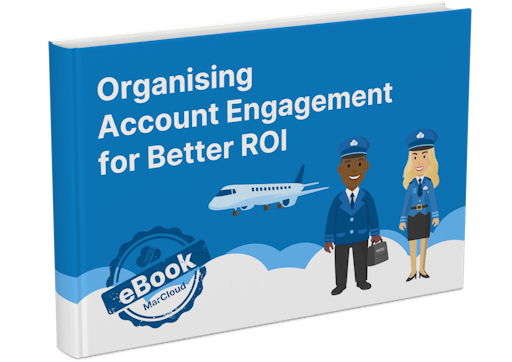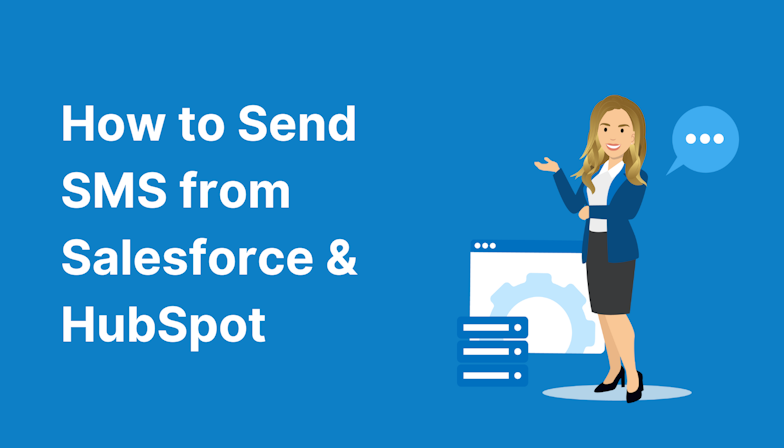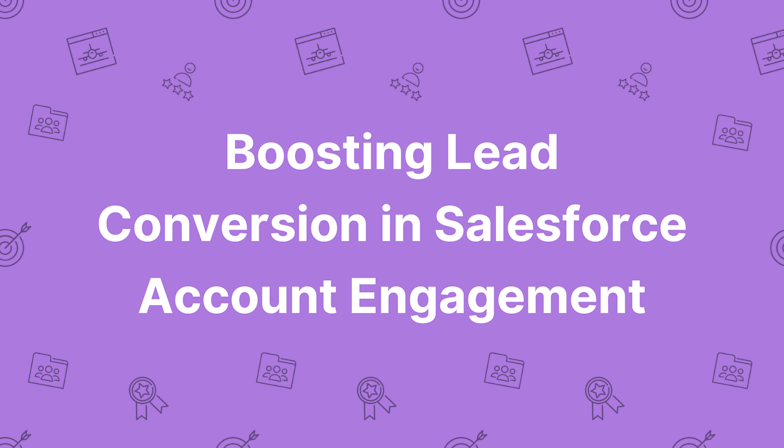This blog was written before Pardot was renamed to Marketing Cloud Account Engagement. You can read more about the name change and what it means here.
The working as one team’ ethic between marketing and sales teams is known for being somewhat imperfect. For this reason, some might assume that Salesforce is for sales while Pardot is for marketers. However, with Pardot and Salesforce sync behaviours as a powerful benefit of using both platforms, collaboration and teamwork become much simpler.
For lead generation to deliver solid business results that keep everyone happy, it is key that both marketers and the sales team are on the same page in that they can view lead data seamlessly at any given time during a customer's journey.
Pardot and Salesforce working together do just that; integrates sales and marketing efforts into one platform.
It lets us bring data, assets, and actions together so that we can have up to date information about a customer’s journey, their interactions with our brand and content, and ultimately the information the sales team can use to tailor their pitch and better win new business.
So what are Pardot to Salesforce sync behaviours?
Read on to find out, learn about typical scenarios and certain stumbling blocks that may occur.
- What is Pardot and Salesforce sync behaviour?
- Triggering a sync
- How sync behaviour actually works
- Using Pardot values to set sync behaviour
- Using Salesforce values to set sync behaviour
- Using most recently updated record values to set sync behaviour
- Exceptions for sync behaviours
What is Pardot and Salesforce sync behaviour?
Many systems have different types of sync behaviours. In Pardot, it simply means “how you want the sync to behave once processed”.
Let’s break it down so we can fully understand how the two systems really work together.
Triggering a sync
One of the questions I’m asked in my position at MarCloud is how often does Pardot sync with Salesforce?’.
As a general rule, prospect records sync every two to four minutes. Most records sync immediately, but Pardot processes sync queues with over 400 records in batches. Standard batch processing syncs 12,000 records per hour.
Certain activities can trigger a sync, whether it be from a prospect, user or system:
Prospect triggers:
- Form submission.
- Form handler submission.
- Landing page submission.
- Email unsubscribe or resubscribe.
User triggers:
- Prospect import.
- Prospect field update.
- Pardot campaign update.
- Assigned user update.
- Manual sync from a prospect record.
System triggers:
- Update records.
- Add prospects to Salesforce campaigns.
- Update Salesforce campaign member status (this form of trigger is only applicable when applying rules or actions through lead management.)
How to trigger a sync for Accounts and Opportunities
Accounts
Salesforce will act as the master for triggering syncs for accounts. It will do this automatically once they are linked to a prospect record in Pardot that is syncing with a Salesforce contact.
In Pardot, the account fields act as read-only and are able to sync records that can be used for lead management purposes such as segmentation and automation ruling.
Opportunities
Once a connector has been established between Pardot and Salesforce, all Opportunities that are tied to contacts via a Contact Role trigger a sync to Pardot.
The contact record must also be syncing to a prospect in Pardot. However, for Opportunities that are tied to accounts only in Salesforce, they do not sync, they must be tied to contacts.
Once synced, Opportunities appear as a read-only field in Pardot and are unable to be deleted. In order to delete you must perform this action in Salesforce, the sync will then trigger and remove from Pardot.
If this is a feature that you wish to disable, this is possible by contacting Pardot support. But do bear in mind that this is a great feature for most users who wish to determine their revenue, whether it be processed or pending.
Can I control the sync?
Yes, you certainly can, using values you can control which platform is king. Read on to find out the different sync behaviours and how this can be controlled.
How sync behaviour actually works
Both Pardot and Salesforce, once connected, could have different fields of data for your prospects and therefore the questions you may have are;
- which data from which platform am I viewing?
- is it up to date?
- how can I change the data?
- why is data reappearing after deletion? This can be a real headache and not a good promotion of a helpful marketing automation system!
To avoid this confusion, admin users can set sync behaviour to manage most prospect fields to update in Pardot, Salesforce or even both, acting as the master to overwrite data from the alternative.
I will now delve into the different values that can be used to do this.
Using Pardot values to set sync behaviour

When using Pardot values, if the values between Pardot and Salesforce are in conflict once synced, Pardot will prosper and overwrite the value within Salesforce.
BUT if a value in Pardot is empty and isn’t in Salesforce, then Salesforce will overwrite the empty field in Pardot… confusing right?
The reason for this is that the mission of both platforms is to deliver you with more data to make decisions, so in their eyes: “what is better than an empty field… a data field,” so it is configured to perform this action following this principle.
You may be asking yourself, why would I use Pardot values to overwrite Salesforce. Well, a few reasons are:
- Importing prospects through Pardot.
- Updating fields (see the scenario below).
- You want to configure which lead is assigned to which user.
Scenario example
You are eager to import a new spreadsheet into Pardot following a recent group discussion between a number of your key clients. Your goal is to update which service provider they are currently using so that you can delegate them in appropriate lists. During import you wish to create or update prospect fields, one being a custom field named “SERVICE PROVIDER” with the following values: SAINT, YOU or QUEUE, that is already mapped to Salesforce.
IF a Pardot value is SAINT but in Salesforce it is QUEUE then the SAINT value overwrites the field data within Salesforce.
IF both Pardot and Salesforce’ values are the same it won’t do anything to the naked eye but it will overwrite the field data within Salesforce during the sync and will update the timestamp on the prospect record to show the “last updated” detail related to the sync.
IF a Pardot value is blank as the client did not state their service provider but in Salesforce it has previous data of YOU then Salesforce will overwrite the empty field in Pardot.
Using Salesforce values to set sync behaviour

When using Salesforce values the same theory is applied but just role reversed. If the values between Salesforce and Pardot are in conflict once synced, Salesforce will prosper and overwrite the value within Pardot.
However, if a value in Salesforce is empty and isn’t in Pardot, guess what will happen?
Yep, Pardot will overwrite the empty field in Salesforce as “a data field is better than an empty field.”
BUT as Salesforce is considered as the master you can configure this so if a field value is empty (null) in Salesforce then it will overwrite a data field in Pardot to become empty.
Allowing Salesforce empty (null) values to overwrite Pardot value
The theory of Salesforce being the master can easily end up being a debate, some for and some against. What it really boils down to is what is right for you! It is there to configure to suit your requirements.
Your organisation may comfortably choose Pardot to be the master due to its users. An example of the pros and cons of this are:
Pros
Your sales team is cleaning up the data they have in their systems as there is a great deal of dummy and false data. They decide to make fields blank, and for that to remain, despite what data is being collected.
Cons
A prospect is filling out a form, this is newly captured data that can update and benefit the prospect’s record. Even though this is new data provided by the prospect it will be lost and become empty (null) due to the sync behaviour.
If allowing Salesforce empty (null) values to overwrite Pardot is a feature that you wish to use (after deep consideration!) you’ll need to contact Pardot support to enable.
Now back to using Salesforce values to set sync behaviour.
You may wish to use the Salesforce value, rather than Pardot, for the following valid reasons:
- As previously mentioned, Salesforce data is to be considered the master.
- Sales users, using Salesforce, may wish to take control of data input.
Scenario example
Your marketing team, who are more interested in creating assets rather than up-to-date data, are preparing for an upcoming campaign. In preparation, they import data within Pardot so they can reach out to all possible prospects. However, some of the prospects are already within Pardot, which has updated fields, one being INDUSTRY. This is important as they have tailored emails to send during the nurturing process. The sales team is fine for marketing to perform this action as they have most fields mapped to use the Salesforce value. Another consideration to note is that they have contacted Pardot support to allow blank or empty values in Salesforce to overwrite values in Pardot.
IF a Salesforce field contains CONSTRUCTION and Pardot’s value contains BASIC METAL PRODUCTION then CONSTRUCTION will overwrite the field data within Pardot.
IF both Salesforce and Pardot’ values are the same it won’t do anything to the naked eye but it will overwrite the field data within Pardot during the sync to CONSTRUCTION and will also update the timestamp on the prospect record to show the “last updated” detail related to the sync.
IF a Salesforce value is empty but in Pardot it has BASIC METAL PRODUCTION then Salesforce will overwrite the filled field to become empty.
Using most recently updated record values

When using the most recently updated record values, once again the same theory applies but based on which platform is most recent.
If the values between Salesforce and Pardot are in conflict once synced, it will take into account which platform is using the most recently updated record.
However, if a value in Salesforce is empty and isn’t in Pardot but Salesforce has the most recently updated record, Pardot’s value will overwrite the empty value in Salesforce. This should now be making sense to why and how this is the case.
As this can constantly change, depending on your users’ input, there are some good examples of when to use this setting, such as:
- You are not confident about which platform you consider to be a master.
- When phone numbers are changing constantly.
- Your network of users are spread geographically and interacting with the same data.
Scenario example
To thank your VIP clients, each year you buy them a gift at Christmas. In order to tailor to their likes and interests you create a custom field to input what you pick up through conversations throughout the year. A marketing user sets the ball rolling by adding BEER into the field and both systems update. Middle of the year approaches and a sales user speaks to them and updates the field to FINE WINE and both systems once again update. A few weeks prior to purchasing, a marketing user then changes this because the key client has emailed in and says CHEESE. The field is updated to become CHEESE in Pardot and both systems update. The team gathers up the data and purchases a delightful cheese board for their VIP client.
In this scenario there is no need for an IF layout as both platforms had been syncing since the start of the year and the use of team collaboration led to knowing what exactly the client wanted, whether it was at the start, middle or prior to Christmas.
A great and simple approach of data being collected throughout the process by both teams, that may indeed generate new business.
Exceptions for sync behaviours
There are some exceptions that sync behaviours take into consideration, some exist in proprietary fields, fields that relate to the prospect (owner).
Email address
As the relationship between the CRM and Pardot is 1:1 it is advised to have one email address. In order to become a prospect, Pardot requires a number of fields, one being email address. As this is key to a prospect’s record this can’t be changed and the sync between the two will always use Pardot’s value.
However, if you have a number of employees that use the same email address within your platform then an alternative option may need to be considered. To allow multiple prospects with the same email address you must select the option: automatically change email addresses in Pardot to reflect changes in Salesforce, this is found in the Salesforce-Pardot Connector Settings.
Opted out/do not email
This is an important feature, especially given GDPR regulations. If a prospect has opted out, which sync value takes president?
When the opted-out field is selected on a prospect’s record, both platforms will regress and change to a preferred value. Admins can override this but of course, it is not advised.
The nuances of Pardot to Salesforce sync behaviours can be a challenge for many users. Hopefully, this post has helped you to better understand how syncs behave and the control you have over these settings.
If you’re experiencing sync errors or would like technical support from a team of Pardot specialists you can contact us for a chat.

Carl Mortimer
Carl spent eight years in sales before moving to consulting in the martech space with Pardot, Marketing Cloud and Sales Cloud. With his first-hand experience, he's able to produce solutions with the full lead-to-revenue cycle in mind. He loves seeing his clients thrive as a result of working together, and this buzz drives him in every project he delivers. Focused on delivering a 5-star experience for clients, Carl is a Salesforce Marketing Champion who actively engages with the Salesforce community both directly and via blog posts.
More by Carl MortimerFeatured resource

Organising Pardot for Better ROI
Tidying your Pardot account is step one in making your life easier, saving time and increasing return on marketing investment! Here you’ll find a complete guide to organising your Pardot account like a pro – whether you’re working with a new implementation or a mature account that’s in a bit of a mess.
Download now




